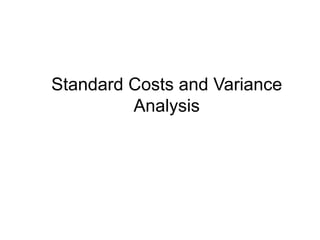
Standard Cost Variance Analysis
- 1. Standard Costs and Variance Analysis
- 2. Objectives 1. Explain how standard costs are developed. 2. Calculate and interpret variances for direct material. 3. Calculate and interpret variances for direct labor.
- 3. Standard Costs Standard cost refers to expected costs under anticipated conditions. • Standard cost systems allow for comparison of standard versus actual costs. • Differences are referred to as standard cost variances. • Variances should be investigated if significant. Standard Costing: Process of establishing the standard cost
- 4. Development of Standard Costs 1. Standard costs are developed in a variety of ways: a. Specified by formulas. b. Developed from price lists provided by suppliers. c. Determined by time studies conducted by industrial engineers. d. Developed from analyses of past data.
- 5. Ideal Versus Attainable Standards Two schools of thought: 1. Ideal standards (perfection standards): developed under the assumption that no obstacles to the production process will be encountered. 2. Attainable Standards: developed under the assumption that there will be occasional problems in the production process.
- 6. Variance Components Total Cost Varinace Material Cost Variance Labour Cost Variance Overhead Variance
- 7. Variance Components Material Cost Variance Price Variance Quantity Variance Mix Variance Yield Variance
- 8. Material Variance When output is not given: 1.Material Cost Variance: Total Standard Material Cost-Total Actual Material Cost 2.Material Price Variance: AQ[SP-AP] 3.Material Quantity Variance: SP[SQ-AQ] where AQ----Actual Quantity SP----Standard Price AP----Actual Price SQ----Standard Quantity
- 9. Material Variance When output is given 1. Material cost variance: Standard cost X Actual Output –Total actual Standard Output material cost 2. Material Price variance: AQ[SP-AP] 3. Material Quantity Variance: SP[Standard Qty. of A X Actual Output –Actual Qty.of A] Standard Output
- 10. Material Variance 4. Material Mix Variance: SP[Standard Qty. of A X Total Actual Qty-Actual Qty. of A] Total Standard Quantity 5.Material Yield Variance: Std Cost[Actual Yield-Standard output X Total Actual Qty] Std Output Total Standard Quantity
- 11. Questions 1)From the data calculate material variances: Standard Actual • A 40 units@50/unit 50 units@50/unit • B 60 units@40/unit 60 units@45/unit 2) The Std. cost of a certain chemical mixture is: 40%material A at Rs. 40/ton 60% material B at Rs. 30/ton A Standard loss of10% is expected in production.
- 12. Questions (contd…) Actual cost of used is: 90 tons of material A @42/ton 160 tons of material B @28/ton Actual output is 230 tons
- 13. You Get What You Measure
- 14. Labour Variance Labour cost variance Labour total Labour rate efficiency variance variance Labour Idle time efficiency variance variance Labour Mix Labour Variance yield variance
- 15. Labour Varinace When output is not given: 1.Labour Cost Variance: Total Standard Labour Cost-Total Actual Labour Cost 2.Labour Rate Variance: AH[SR-AR] 3.Labour Efficiency Variance: SR[SH-AH] where AH---Actual Hours SR---Standard Rate AR---Actual Rate SH---Standard Hours
- 16. Labour Varinace When output is given 1. Labor cost variance: Standard cost X Actual Output –Total actual Standard output labour cost 2.Labour Rate Variance: AH[SR-AR] 3. Labour Efficiency Variance: SR[Standard Hrs. of A X Actual Output –Actual Hrs.A] Standard Output
- 17. Labour Varinace 4. Labour Mix Variance: SR[Standard Hrs. of A X Total Actual Hrs -Actual Hrs. of A] Total Standard Hrs 5.Labour Yield Variance: SR[Actual Yield-Standard output X Total Actual Hrs. Total Standard Hrs. Where SR=Standard Cost Standard Output 6. Idle Time Variance: Idle Time X Standard Rate When Idle time=0,then LTEV=LEV
